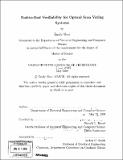End-to-end verifiability for optical scan voting systems
Author(s)
Shen, Emily (Emily Huei-Yi)
DownloadFull printable version (7.816Mb)
Other Contributors
Massachusetts Institute of Technology. Dept. of Electrical Engineering and Computer Science.
Advisor
Ronald L. Rivest.
Terms of use
Metadata
Show full item recordAbstract
End-to-end verifiable voting systems allow voters to verify that their votes are cast as intended, collected as cast, and counted as collected. Essentially, end-to-end voting systems provide voters assurance that each step of the election worked correctly. At the same time, voting systems must protect voter privacy and prevent the possibility of improper voter influence and voter coercion. Several end-to-end voting systems have been proposed, varying in usability and practicality. In this thesis we describe and analyze Scantegrity II, a novel end-to-end verification mechanism for optical scan voting which uses confirmation codes printed on the ballot in invisible ink. The confirmation codes allow voters to create privacy-preserving receipts which voters can check against the bulletin board after the close of the election to ensure that their votes have been collected as cast. Anyone can check that votes have been counted as collected and that the tally is correct. We describe the Scantegrity II system and analyze the integrity and privacy properties it provides.
Description
Thesis (S.M.)--Massachusetts Institute of Technology, Dept. of Electrical Engineering and Computer Science, 2008. Includes bibliographical references (p. 57-59).
Date issued
2008Department
Massachusetts Institute of Technology. Department of Electrical Engineering and Computer SciencePublisher
Massachusetts Institute of Technology
Keywords
Electrical Engineering and Computer Science.